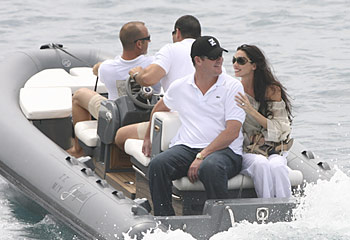Packer wedding in grand tradition
DOZENS of rich and famous people have tied the knot on the Riviera before James Parker and his bride. Troy Lennon reports on the playground.

IT is not only the beach, sand, sea and sparkling blue skies that draw people there but also the luxury hotels and the desire to be seen in the company of those who can afford them.
The French Riviera has been a holiday destination for the wealthy and famous for more than a century.
A place to relax, to mix and mingle, even a place to tie the knot. James Packer is said to be marrying fiancee Erica Baxter along one of the most exclusive stretches of what is also known as the Cote d'Azur – the coast of azure. The name was coined by the poet Stephen Liegeard in 1887, who likened the brilliant blue sky and ocean to the semi-precious stone azure. It is a place for romance to blossom.
It might seem somewhat unromantic, but consumption and cholera actually played an important part in making the French Riviera the gathering place that it now is.
The English had been travelling to Nice on and off since about 1730 to escape the chill of the English winter – whenever the political situation allowed.
The ocean, however, was generally not something that the holidaying Brits were drawn to, especially in the relative cool of winter.
But one adventurous Scot, Tobias Smollett – doctor, diarist, poet, novelist, travel writer and historian – dared to venture to the seashore. In his 1766 book Travels Through France And Italy, he described a May 1764 journey to the seaside where he was carried to the seashore "two miles" from his house in a sedan chair.
Smollet said: "They thought it very strange, that a man seemingly consumptive should plunge into the sea, especially when the weather was so cold; and some of the doctors prognosticated immediate death. But, when it was perceived that I grew better in consequence of the bath, some of the Swiss officers tried the same experiment, and in a few days, our example was followed by several inhabitants of Nice."
His example was followed by many readers of his book.
One regular visitor was Lord Henry Brougham, one-time lord chancellor and anti-slavery activist. During a visit in 1834 he found Nice in the grip of a cholera epidemic and travelled down the coast to Cannes. He then set a trend of returning there every year.
Other English tourists soon followed, discovering their own havens along this picturesque stretch of coastline. Nice remained the most popular city, even frequented by Queen Victoria herself, but Cannes, Antibes, Monaco and Saint Tropez were also popular.
Other European royalty also made their way to the French Riviera. In 1856 Empress Alexandra Feodorovna of Russia chose Nice as her winter retreat. Emperor Napoleon III of France also became a regular visitor after Nice was ceded to France by Italian states headed by Sardinia in 1860 to thank France for its help in winning independence for Italy from Austria.
By the end of the 19th century the English were joined by artists, poets, writers and increasing numbers of wealthy Americans. Upper-class Americans often followed the habits of their British counterparts, possibly hoping that some of the magic of old-world aristocracy would rub off. Artists were also drawn to the mild climate and sunshine of the Riviera. Andre Derain and Henri Matisse were two artists who set up an artists' colony there before World War I.
After this war Americans almost began to outnumber other tourists. During the Roaring 1920s, there was a major influx of US millionaires, writers and movie stars. But it was mostly seen as a winter destination until one American couple hired out an old hotel for the summer.
Glamorous bohemian socialites Gerald and Sara Murphy were both children of wealthy parents. The couple often played host to writers, artists, celebrities and other socialites during summer in the Hamptons on Long Island.
There they did whatever bohemian things took their fancy, serving as a model for characters in Francis Scott Fitzgerald novels.
Finding the Cote d'Azur, they did the bohemian thing again and hired the Hotel du Cap Eden Roc on the Cap d'Antibes in 1923 for a summer fling. Fitzgerald was one of the many guests and he later modelled his Hotel des Etrangers in the novel Tender Is The Night on the Hotel du Cap – the hotel where James Packer will hold his wedding reception.
After that, it became trendy to spend summer on the French Riviera. Swimming in the waters and sunbathing on the beaches became popular pastimes, the women's costumes becoming more and more skimpy throughout the '20s and '30s, until World War II temporarily curtailed most of the pleasure seekers.
While the south of France was controlled by Marshal Henri Petain's Vichy government, German officers still availed themselves of the luxurious hotels and homes on the Riviera. They came partly to watch out for invasion along the Cote d'Azur, parts of which were protected by mines and barbed wire. The area was also a hotbed of resistance activity, which would have allowed the Germans little opportunity to relax.
After the war, the party started again and more famous people took up residence. Among those who made the coast their home was the artist Pablo Picasso in 1955. In 1961 at the age of 79, he married his model Jacqueline Roque, 35, at Vallauris near Cannes. It was the second marriage for both of them.
There were also many more film stars. Some visited not only for fun but also for work. The Cannes Film Festival, first held in 1939, became an important place for promoting new films and for networking. Studios also often use the Riviera as a stunning backdrop for films.
It was in 1955, while filming To Catch A Thief with Cary Grant, that Grace Kelly met Prince Rainier of Monaco. The two later married and Princess Grace made the Riviera her home.
The rise of the pop-music superstars from the 1950s also created a new wave of residents to the exclusive area. Bill Wyman would send up the image of the lowbrow rock star living in the exclusive land of the wealthy with his 1981 song Je Suis Un Rock Star.
But the exclusivity sometimes led to conflict. A bitter battle was fought to stop the rich sectioning off their beaches for private use and restricting public access. Private landowners built stone walls or topped fences with barbed wire to keep people out, or charged for access, until the government put a stop to it in 1971.
In 1979, 23 people died in a tsunami caused by undersea landslides. Most of the casualties were among men building an extension to the runway at Nice airport.
Today, British millionaires and socialites make up a minority of visitors and residents. Arab oil billionaires rub shoulders with rock stars, movie stars and even Australian media magnates.
The Hotel Cap du Eden Roc remains one of the most exclusive establishments on the French Riviera. It has an impressive guest list of recent movie stars including Clint Eastwood, Julie Andrews, Harrison Ford, Robert De Niro, John Travolta and even our own Cate Blanchett. One past guest, actress Helena Bonham Carter, provides a link with its upper-crust British past, as the daughter of a baroness and great granddaughter of early 20th century British prime minister Herbert Asquith.



